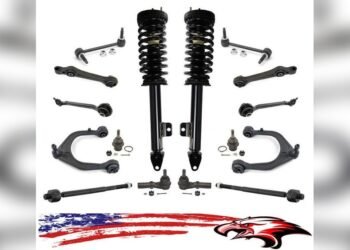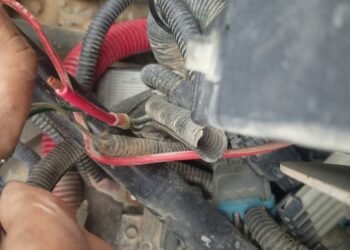The most common GM 4L60 transmission problems include hard shifts, slipping between gears, and delayed engagement. Internal component overhaul and replacing worn out parts can help repair these issues.
In some cases, broken drive shells and worn TCC regulator valves may need to be addressed. It is important to address these issues promptly to avoid further damage to the transmission. The GM 4L60 transmission is a popular transmission used in many vehicles, including the Chevy Silverado and GMC Sierra.
However, like any transmission, it can experience problems over time. We will discuss some of the most common GM 4L60 transmission problems and how to address them. By understanding these issues, you can take steps to maintain your transmission and keep it running smoothly for years to come.

Credit: www.youtube.com
Introduction To 4l60 Transmission Issues
Explore common GM 4L60 transmission problems, including overheating, premature wear, slipping between gears, delayed engagement, and grinding noises. Repairs may involve internal component overhauls to address these issues effectively.
Common Symptoms Of Failure
The 4L60 transmission issues can manifest in various common symptoms:
- Overheating due to internal component wear
- Premature wear leading to decreased performance
- Slipping between gears, affecting smooth transitions
- Delayed engagement when shifting, causing inconvenience
- Grinding noises indicating potential serious damage
The Impact On Vehicle Performance
The problems with the 4L60 transmission can significantly impact vehicle performance:
- Poor line pressure leading to inefficient operation
- High temperatures affecting overall functioning
- Flared shifts causing discomfort during driving
- Other generic drivability concerns affecting the overall driving experience

Credit: nextgendiesel.com
The Dreaded Hard Shift
One of the most common and frustrating issues that owners of vehicles equipped with the GM 4L60 transmission encounter is the dreaded hard shift. This problem can cause discomfort, reduced performance, and potential long-term damage to the transmission if not addressed promptly. In this article, we will explore the hard shift phenomenon, its potential causes, and what you can do to resolve it.
Hard Shift Explained
When a hard shift occurs, it refers to a sudden and jarring transition between gears, often accompanied by a noticeable jolt or jerk. This abrupt gear change can be felt by both the driver and passengers, creating an unpleasant driving experience and potentially signaling underlying issues within the transmission system.
Potential Causes Of Hard Shifting
Several factors can contribute to the occurrence of hard shifting in the GM 4L60 transmission. Identifying the root cause is crucial in effectively addressing the problem and preventing further damage. Common potential causes of hard shifting include:
- Low transmission fluid levels
- Worn or damaged transmission bands
- Malfunctioning shift solenoids
- Issues with the transmission control module
- Worn or damaged clutch components
Addressing these potential causes through proper diagnosis and timely repairs or maintenance can help alleviate the hard shift problem and ensure the longevity of the transmission system.
Problems In Specific Gears
When it comes to the 4L60 transmission, specific gear problems can cause significant issues for vehicle owners. Understanding the challenges associated with individual gears is crucial for diagnosing and addressing transmission issues effectively.
Challenges In 2nd And 4th Gear
The 4L60 transmission may experience issues specifically in the 2nd and 4th gears. Shifting problems, slipping, or delayed engagement in these gears can indicate underlying mechanical or hydraulic issues that require attention. These issues can lead to poor performance and potential safety concerns for the driver.
Reverse Gear Failures
Reverse gear failures can manifest as delayed engagement, slipping, or complete non-engagement. These issues can be attributed to worn-out “lo-reverse” clutches, fluid leaks in the reverse apply circuit, or a broken sunshell. Addressing these problems promptly is essential to prevent further damage to the transmission system.
No Third Gear Scenario
A scenario where there is no third gear can lead to erratic shifting behavior and compromised driving experience. This issue may stem from various factors such as worn TCC regulator valve, malfunctioning pistons, or a damaged sunshell. Identifying and resolving the root cause of the no third gear scenario is vital to restore the transmission’s functionality.
Shift Solenoid Malfunctions
Shift solenoid malfunctions can cause various issues in the 4L60 transmission, impacting the vehicle’s performance and drivability. Understanding the role of shift solenoids and recognizing signs of solenoid failure is crucial for diagnosing and resolving transmission problems.
Role Of Shift Solenoids
Shift solenoids are vital components in the 4L60 transmission, responsible for controlling the flow of transmission fluid and facilitating gear shifts. These electromagnetic valves play a key role in regulating hydraulic pressure to engage specific gears, ensuring smooth and precise transmission operation.
Signs Of Solenoid Failure
Identifying potential solenoid failure is essential for timely transmission maintenance. Some common signs of shift solenoid malfunction include delayed or erratic shifting, abnormal gear shifts, harsh engagement, and loss of specific gears. Additionally, a diagnostic trouble code (DTC) related to shift solenoid performance may be triggered, indicating the need for thorough inspection and potential solenoid replacement.
Torque Converter Troubles
The torque converter is a crucial component of the 4L60 transmission, responsible for transferring power from the engine to the transmission. However, like any other part, it can encounter issues that affect the overall performance of the transmission system. Understanding the function and recognizing symptoms of torque converter issues is essential for diagnosing and addressing problems effectively.
Function Of The Torque Converter
The torque converter serves to transmit power from the engine to the transmission, allowing the vehicle to move forward. It operates through the use of fluid coupling, enabling smooth and efficient power transfer without the need for a manual clutch.
Symptoms Of Torque Converter Issues
- Slipping: The vehicle may experience slipping between gears, indicating potential torque converter problems.
- Overheating: Excessive heat generation within the torque converter can lead to performance issues and premature wear.
- Delayed Engagement: Difficulty in shifting or delayed engagement when putting the vehicle in gear can be indicative of torque converter troubles.
- Grinding Noises: Unusual grinding or abnormal noises during gear shifts may signal underlying torque converter issues.
In the event of any of these symptoms, it is crucial to address torque converter problems promptly to prevent further damage to the transmission system.
Overheating And Wear
When it comes to the Gm 4L60 transmission, overheating and premature wear are common issues that can lead to serious transmission problems. Understanding the causes of overheating and the effects of premature wear is crucial for ensuring the longevity and performance of your transmission.
Causes Of Overheating
Overheating in the Gm 4L60 transmission can be caused by various factors, including low fluid levels, improper fluid, clogged transmission cooler, faulty cooling system, and excessive towing or hauling. When the transmission overheats, it can lead to fluid breakdown, accelerated wear on internal components, and loss of lubrication, which in turn can result in severe damage to the transmission.
Effects Of Premature Wear
Premature wear in the Gm 4L60 transmission can have detrimental effects on the overall performance and reliability of the transmission. Worn clutches, bands, gears, and valves can result in slipping between gears, delayed engagement, and grinding noises. Additionally, premature wear can lead to increased friction, loss of hydraulic pressure, and inefficient torque transfer, ultimately causing hard shifts and erratic behavior.
Slipping Between Gears
One of the most common issues that drivers face with the Gm 4L60 transmission is gear slippage. When your transmission slips between gears, it can lead to a range of performance and safety issues. Understanding the causes of gear slippage and how to diagnose and address this problem is crucial for maintaining the health and functionality of your transmission.
Understanding Gear Slippage
Gear slippage in the Gm 4L60 transmission occurs when there is a loss of power transmission between gears. This can manifest as delayed or rough shifting, unexpected downshifting, or a sensation of the vehicle slipping out of gear. The most common causes of gear slippage include worn or damaged clutch plates, low transmission fluid levels, or problems with the transmission bands and solenoids.
Diagnosing And Addressing Slippage
Diagnosing gear slippage involves conducting a comprehensive inspection of the transmission system, including checking the fluid levels, examining the condition of the clutch plates, and testing the transmission bands and solenoids. Addressing gear slippage may require replacing worn or damaged components, performing a transmission fluid flush and filter replacement, or adjusting the transmission bands to ensure proper tension and operation.

Credit: nextgendiesel.com
Repair And Overhaul Solutions
Repair and Overhaul Solutions for GM 4L60 Transmission Problems
When To Overhaul
Overhauling the GM 4L60 transmission is necessary when experiencing issues such as overheating, premature wear, slipping between gears, delayed engagement, or grinding noises.
Choosing A Repair Approach
When faced with GM 4L60 transmission problems like poor line pressure, high temperatures, flared shifts, or other drivability concerns, consider internal component overhaul as a viable repair solution.
Preventive Measures And Maintenance Tips
Regularly scheduled maintenance can help prevent common 4L60 transmission problems.
Upgrades For Enhanced Durability
Consider upgrading certain components for increased durability and performance.
- Upgrade to high-quality transmission fluid
- Install a transmission cooler for better heat dissipation
- Replace worn-out seals and gaskets
Preventive Maintenance Tips
Follow these maintenance tips to keep your 4L60 transmission running smoothly:
- Check transmission fluid levels regularly
- Inspect for leaks and address promptly
- Perform regular fluid flushes and filter changes
- Listen for any unusual noises or vibrations
- Have a professional inspection at recommended intervals
By following these preventive measures and maintenance tips, you can extend the lifespan of your 4L60 transmission and avoid costly repairs.
Frequently Asked Questions
What Is The Most Common Failure For 4l60e?
The most common failure for 4L60E is the transmission control module. Other common failures include hard shift, slipping between gears, delayed engagement, grinding noises, and no reverse gear. Some of the internal components that can cause these issues include the shift solenoid, torque converter, and the 4th gear.
Overheating, premature wear, and broken drive shell can also lead to transmission failure. Proper maintenance and timely repairs can prevent these failures.
How To Tell If A 4l60e Is Going Bad?
If your 4L60E transmission is going bad, you may experience hard shifts, slipping between gears, delayed engagement, grinding noises, and no reverse. Other signs may include overheating, premature wear, and poor line pressure. Internal component overhaul may be necessary for repair.
You can also check for worn out clutches, fluid leaks, or a broken sunshell.
Is The 4l60 A Good Transmission?
Yes, the 4L60 transmission is known for its reliability and performance, making it a good choice.
Why Is The 4l60e A Bad Transmission?
The 4L60E transmission is often criticized for issues like overheating, premature wear, and slipping between gears. Common repairs involve internal component overhauls to address these problems effectively.
What Are Common 4l60 Transmission Problems?
Common issues include slipping, overheating, grinding noises, and delayed engagement between gears.
Conclusion
Addressing GM 4L60 transmission problems promptly can prevent costly repairs down the line. Whether it’s slipping gears or delayed engagement, identifying and fixing issues early is key. Regular maintenance and proper care can extend the lifespan of your transmission, ensuring smooth driving experiences.
















